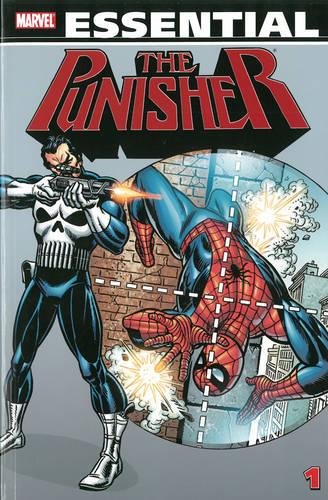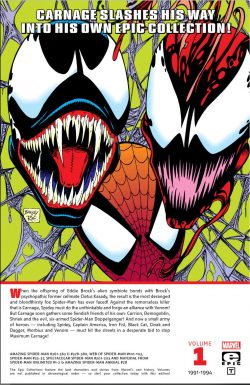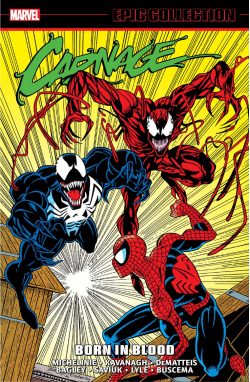
By Gerry Conway, Archie Goodwin, Len Wein, Mike W. Barr, Marv Wolfman, Dennis O’Neil, Roger McKenzie, Frank Miller, Bill Mantlo, Stephen Grant, Jo Duffy, Ross Andru, Tony DeZuniga, Frank Springer, Keith Pollard, Al Milgrom, Greg LaRocque, Mike Zeck, Mike Vosburg & various (MARVEL)
ISBN: 978-0-8571-2375-0 (TPB)
Debuting in 1974 and despite being one of the industry’s biggest hits from the mid-1980s onwards, the obsessed vengeance-taker known as The Punisher was always an unlikely and uncomfortable star for comic books. His methods were excessively violent and usually permanent. It’s intriguing to note that unlike most heroes who debuted as villains (Black Widow or Wolverine come to mind) the Punisher actually became more ruthless, immoral, anti-social and murderous, not less. The Punisher never toned down or cleaned up his act – the buying public simply shifted its communal perspective.
He was created by Gerry Conway, John Romita Sr. and Ross Andru: a (necessarily) toned down, muted response to increasingly popular prose anti-heroes like Don Pendleton’s Mack Bolan: the Executioner and a bloody tide of fictive Viet Nam vets returned from South East Asia who all turned their training and talents to wiping out organised crime in the early 1970s. The story goes that Marvel’s bosses were reluctant to give The Punisher a starring vehicle in the mainstream colour comic-book line, feeling the character’s very nature made him a bad guy, not a good one. Other than the two magazine stories and the miniseries which closes this volume, Frank Castle was not supposed to be the star or even particularly admirable to the impressionable readership.
Therefore these early appearances could disappoint die-hard fans even though they are the formative tales of his success. Perhaps it’s best to remember and accept that when not actually the villain in the tales he was at best a controversial guest and worrisome co-star…
Boy, how times do change.
He was first seen as a villain/patsy in Amazing Spider-Man #129 (cover-dated February 1974 but actually on sale from 30th October 1973 – so even in terms of his anniversary, Castle apparently “jumped the gun” (I’m so weak!). He repeatedly returned thereafter until getting his shot at the big time – just not in newsstand publications but in Marvel’s monochrome, mature magazine line. This initial Essential compilation gathers all those tentative stabs and guest-shots from February 1974 through to the breakthrough 1986 miniseries which really got the ball rolling. These include Amazing Spider-Man #129, 134-135, 162-163, 174-175, 201-202; Amazing Spider-Man Annual #15; Giant-Size Spider-Man #4; Marvel Preview #2; Marvel Super-Action #1; Captain America #241; Daredevil #182-184; Peter Parker, The Spectacular Spider-Man #81-83 and The Punisher #1-5, but many die-hard modern fans may be disappointed in the relative lack of brutality, carnage and even face time contained herein. Just keep in mind that for the greater part of these early appearances the skull-shirted slayer was at best a visitor and usually the villain du jour…
The first case in this mammoth monochrome war journal comes from ASM #129, introducing not only the renegade gunslinger but also nefarious manic mastermind The Jackal in ‘The Punisher Strikes Twice!’ Scripted by Conway, and illustrated by Ross Andru, Frank Giacoia & Dave Hunt, it reveals how a mystery lone gunman is duped by manipulative Professor Miles Warren into hunting the wallcrawler who was wrongly implicated in the deaths of police captain George Stacy and his daughter Gwen and currently a suspect in the death of Norman Osborn. Here he is subsequently set up by The Jackal for the murder of the Punisher’s gunmaker before clearing the air and going their own ways…
The much-misunderstood champions of the oppressed crossed paths again in Amazing Spider-Man #134-135 when a South American bandit – intended to be his oppressive regime’s Captain America – attempts to pillage a Manhattan tour boat in ‘Danger is a Man Named… Tarantula!’ Once again unwilling allies, Spidey and the Punisher’s trails cross when the duo dutifully dismantle the villain’s schemes during a ‘Shoot-Out in Central Park!’
The Punisher played a more central role in Giant-Size Spider-Man #4 (April 1975) when the webslinger forces himself into one of the sinister shootist’s cases in ‘To Sow the Seeds of Death’s Day!’ when ruthless arms dealer Moses Magnum began testing a deadly chemical weapon on randomly kidnapped victims. Tracking down the vile monster in ‘Attack of the War Machine!’, the reluctant allies found themselves infiltrating his ‘Death-Camp at the Edge of the World!’ before seeing summary justice dispensed more by fate than intent…
John Romita Senior’s original concept pencil sketch of The Punisher from 1973 is followed by the vigilante’s first solo role – in black-&-white magazine Marvel Preview #2 (August 1975) – wherein Conway & Tony DeZuñiga pronounced a ‘Death Sentence’ on some of Castle’s old army buddies. They had been tricked into becoming assassins by a millionaire madman who wanted to take over America, as the gritty yarn at last revealed the tragic reasons for The Punisher’s unending mission of vengeance.
Highly decorated Marine Castle saw his wife and children gunned down in Central Park after the carefree picnickers stumbled into a mob hit. When the killers turned on the helpless witnesses, only Castle survived. Recovering in hospital, the bereft warrior dedicated his life to eradicating criminals everywhere. Following a stunning Punisher and Dominic Fortune pin-up by Howard Chaykin, Archie Goodwin, DeZuñiga & Rico Rival’s ‘Accounts Settled… Accounts Due!’ – from Marvel Super Action #1 (January 1976) – draws another matured-themed plot to a close as Castle finally tracks down the gunsels who carried out the shooting and the Dons who ordered it, only to find his bloody vengeance hasn’t eased his heart or dulled his thirst for personal justice…
Castle was reduced to a bit-player in Amazing Spider-Man #162-163 (October & November 1976 by Len Wein Andru & Mike Esposito), as the newly relaunched X-Men were sales-boosted via a guest-clash with the webspinner in ‘…And the Nightcrawler Came Prowling, Prowling’. Here Spider-Man jumps to wrong conclusion when a sniper shoots a reveller at Coney Island and by the time Nightcrawler has explained himself (in the tried-&-true Marvel manner of fighting the star to a standstill) old skull-shirt has turned up to take them both on. Soon however, mutual foe Jigsaw is exposed as the true assassin in concluding episode ‘Let the Punisher Fit the Crime!’
Inked by DeZuñiga & Jim Mooney, November 1977’s ASM #174 declared ‘The Hitman’s Back in Town!’ with Castle hunting a costumed assassin hired to rub out J. Jonah Jameson, but experiencing unusual reticence since the killer is an old army pal who had saved his life in Vietnam. Nevertheless the tale ends in fatality at the ‘Big Apple Battleground!’ in #175.
Captain America #241 (January 1980, by Mike W. Barr, Frank Springer & Pablo Marcos) was a fill in benefitting from the Frank Miller effect – he drew the cover – as ‘Fear Grows in Brooklyn’ depicted the Sentinel of Liberty getting in the way of Castle’s latest mission and refusing to allow The Punisher to go free. Cap wasn’t on hand stop him escaping police custody and Amazing Spider-Man #201-202 (February & March 1980) by Marv Wolfman, Keith Pollard & Mooney. ‘Man-Hunt!’ and ‘One For Those Long Gone!’ reveal how Castle almost uncovers Peter Parker‘s big secret whilst relentlessly stalking a mob boss responsible for the death of a kid who had saved Castle’s life…
Amazing Spider-Man Annual #15 (1981 by Dennis O’Neil, Miller & Klaus Janson) is putatively the genesis of the antihero in his proper form. ‘Spider-Man: Threat or Menace?’ sees maniac fugitive Castle back in the Big Apple and lethally embroiled in a deadly scheme by Doctor Octopus to poison five million New Yorkers. Soon both Parker and his colourful alter-ego are trapped dead-centre of a terrifying battle of ruthless wills in a tense and clever suspense thriller, highlighting and recapturing the moody mastery of Steve Ditko’s heyday.
The Miller connection continued in three landmark issues of Daredevil (#182-184, May-July 1982) which ideally embody everything that made The Punisher a momentous, unmissable, “must-read” character…
It is presaged by an untitled excerpt by Miller & Janson from ‘She’s Alive’ – wherein Castle is extracted from prison by a government spook to stop a shipment of drugs the authorities can’t touch. Meanwhile a shattered Matt Murdock is failing to cope with the murder of his first love Elektra. Of course, once Castle has stopped the drugs and killed the gangsters, The Punisher refuses to go back to jail…
The story proper begins in ‘Child’s Play’ – with Roger McKenzie lending a scripting hand – and deals with school kids using drugs. It was originally begun by McKenzie & Miller but shelved for a year, before being reworked into a stunningly powerful, unsettling tale once Miller & Janson assumed full creative chores on Daredevil. When Murdock visits a high school he is a helpless witness to a little girl high on “Angel Dust” going berserk, attacking staff and pupils before throwing herself out of a third floor window The appalled hero vows to find the dealers and encounters her bereaved and distraught younger brother Billy, determined to exact his own vengeance, and later coldly calculating Castle who has the same idea and far more experience…
The hunt leads inexorably to a certain street pusher and DD, Billy and The Punisher all find their target at the same time. After a spectacular battle a thoroughly beaten Daredevil has Billy, a bullet-ridden corpse and a smoking gun…
The kid is innocent – and so, this time at least, is Castle – and after Murdock proves it in court, the investigation resumes with the focus falling on drug boss Hogman. When DD’s super-hearing confirms the gangster’s claims of innocence, Murdock successfully defends the vile dealer, only to have the exonerated slimeball gloatingly admit to having committed the murder after all! Horrified, shocked, betrayed and resolved to enforce justice, DD finds a connection to a highly-placed member of the school faculty deeply involved with the drug lord in concluding chapter ‘Good Guys Wear Red’, but it’s far too late: Castle and Billy have both decided to end the matter Hogman’s way…
Scripted by Bill Mantlo and illustrated by Al Milgrom & Mooney, Peter Parker, The Spectacular Spider-Man #81-83 (August-October 1983) opens with ‘Stalkers in the Shadows’ as an increasingly crazed Punisher goes after misdemeanour malefactors with the same murderous zeal previously reserved for killers and worse. Spider-Man meanwhile, has his hands full with teen vigilantes Cloak and Dagger who have graduated from tackling street drug pushers to go after Wilson Fisk, The Kingpin of crime.
‘Crime & Punishment!’ sees Castle applying lethal force indiscriminately all over town, culminating in his own crazed attack on Fisk… who beats him to a pulp. Illustrated by Greg LaRoque & Mooney the saga ends with ‘Delusions’ as The Punisher goes on trial and is found to have been dosed with psychosis-inducing drugs…
In 1984 Marvel gave way to the inevitable and commissioned a Punisher miniseries, although writer Steven Grant and penciller Mike Zeck apparently had an uphill struggle convincing editors to let the grim, gun-crazed maniac loose in the shiny world where little kids might fixate on a dangerous role model – and their parents might get all over-protective, litigious and (skull) shirty. A year later the creators finally got the green-light and a 5-issue miniseries – running from January to May – turned the industry on its head. There was indeed plenty of controversy to go around, especially as the tale featured a “hero” who had lots of illicit sex and killed his enemies in cold blood. Also causing problems for censorious eyes were the suicide of one of the major characters and the murder of innocent children. Doesn’t it make you proud to realise how far we’ve since come?
The company mitigated the potential fall-out with the most lacklustre PR campaign in history, but not telling anybody about The Punisher (AKA Circle of Blood) didn’t stop the series becoming a runaway, barnstorming success. The rest is history. Two years later as the graphic novel market was becoming established and with Frank Castle one of the biggest draws in comics (sorry, I’m such a child sometimes), that contentious series was released as a complete book and it remains one of the very best of all his many exploits.
Here, rendered even more stark and uncompromising in gritty moody monochrome, the action begins in ‘Circle of Blood’ as Castle is locked in Ryker’s Island prison where every inmate is queuing up to kill him. Within hours he has turned the tables and terrified the General Population, but knows both old foe Jigsaw and the last of the great mob “Godfathers” have special plans for him…
When a mass breakout frees all the cons, Castle brutally steps in. For this the warden allows his escape and offers him membership in The Trust: an organisation of “right-minded, law-abiding citizens” who approve of his crusade. Castle also learns he’s being stalked by Tony Massera, a good man who thought he had escaped the influences of his crime-family…
Tony must kill Castle to avenge his father – one of Punisher’s many gory successes – but only after the streets have been swept clean of scum like his own relations. ‘Back to the War’ finds Punisher on the streets again, hunting scum, armed and supplied by the Trust… but still not a part of their organisation. After an abortive attempt to blow up The Kingpin, Castle is saved by the enigmatic Angel, and begins a loveless liaison with her. With everybody mistakenly believing the master of New York’s underworld dead, bloody gang-war erupts with greedy sub-bosses all trying to claim the top spot, but by the events of ‘Slaughterday’, Castle realises too many innocents are getting caught in the crossfires.
He also discovers in ‘Final Solution’ that the Trust have their own national agenda as hit men and brainwashed criminals dressed in his costume swarm the streets, executing mobsters and fanning the flames. All the Trust’s plans for this “Punishment Squad” and the country are uncovered in blockbusting conclusion ‘Final Solution Part 2’, when all the pieces fall into place and the surviving players reveal their true allegiances. In a classy final chapter mysteriously completed by the highly underrated Jo Duffy& Mike Vosburg, from Grant’s original plot, The Punisher takes charge in his inimitable manner, leaving God and the cops to sort out the paperwork. We can only speculate as to why the originators fell away at the last hurdle, but I’m pretty sure those same reluctant editors played some part in it all…
This economical Essential edition comes with a plethora of pin-ups, concluding with comprehensive information pages culled from the Marvel Universe Handbook.
These superb, morally ambiguous if not actually ethically challenging dramas never cease to thrill and amaze, and have been reprinted a number of times. Whichever version suits your inclinations and wallet, if you love action, cherish costumed comics adventure and crave the occasional dose of gratuitous personal justice, this one should be at the top of your “Most Wanted” list.
© 1974, 1975, 1976, 1977, 1980, 1981, 1982, 1983, 1986, 2011 Marvel Characters, Inc. All rights reserved.


